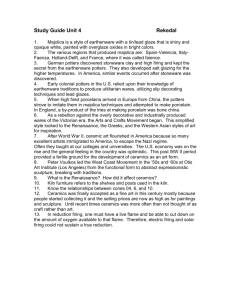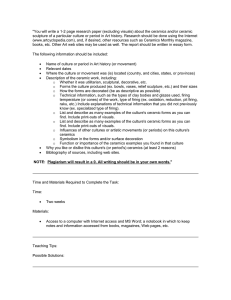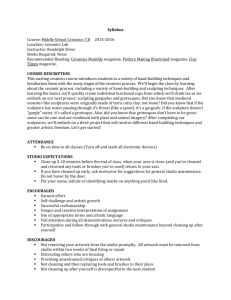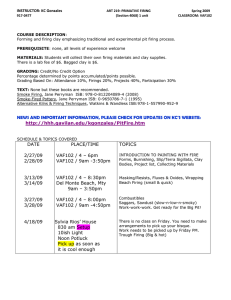Third Millennium Venus Sherri Lisota Faculty Sponsor: Karen Terpstra, Department of Art ABSTRACT
advertisement
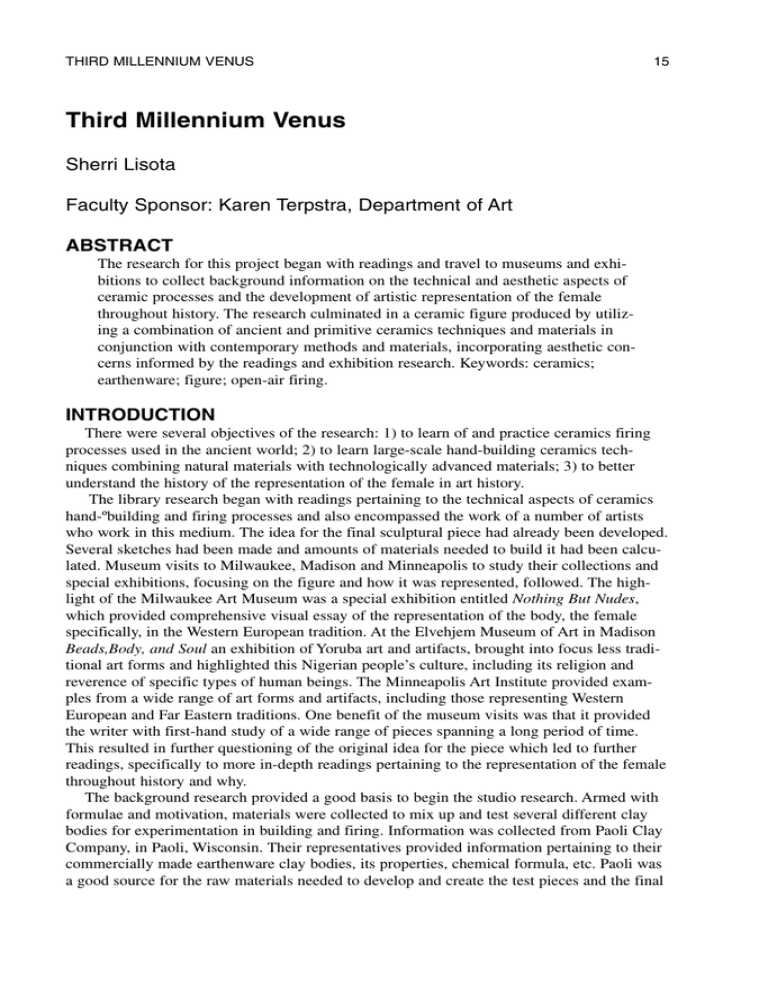
THIRD MILLENNIUM VENUS 15 Third Millennium Venus Sherri Lisota Faculty Sponsor: Karen Terpstra, Department of Art ABSTRACT The research for this project began with readings and travel to museums and exhibitions to collect background information on the technical and aesthetic aspects of ceramic processes and the development of artistic representation of the female throughout history. The research culminated in a ceramic figure produced by utilizing a combination of ancient and primitive ceramics techniques and materials in conjunction with contemporary methods and materials, incorporating aesthetic concerns informed by the readings and exhibition research. Keywords: ceramics; earthenware; figure; open-air firing. INTRODUCTION There were several objectives of the research: 1) to learn of and practice ceramics firing processes used in the ancient world; 2) to learn large-scale hand-building ceramics techniques combining natural materials with technologically advanced materials; 3) to better understand the history of the representation of the female in art history. The library research began with readings pertaining to the technical aspects of ceramics hand-ºbuilding and firing processes and also encompassed the work of a number of artists who work in this medium. The idea for the final sculptural piece had already been developed. Several sketches had been made and amounts of materials needed to build it had been calculated. Museum visits to Milwaukee, Madison and Minneapolis to study their collections and special exhibitions, focusing on the figure and how it was represented, followed. The highlight of the Milwaukee Art Museum was a special exhibition entitled Nothing But Nudes, which provided comprehensive visual essay of the representation of the body, the female specifically, in the Western European tradition. At the Elvehjem Museum of Art in Madison Beads,Body, and Soul an exhibition of Yoruba art and artifacts, brought into focus less traditional art forms and highlighted this Nigerian people’s culture, including its religion and reverence of specific types of human beings. The Minneapolis Art Institute provided examples from a wide range of art forms and artifacts, including those representing Western European and Far Eastern traditions. One benefit of the museum visits was that it provided the writer with first-hand study of a wide range of pieces spanning a long period of time. This resulted in further questioning of the original idea for the piece which led to further readings, specifically to more in-depth readings pertaining to the representation of the female throughout history and why. The background research provided a good basis to begin the studio research. Armed with formulae and motivation, materials were collected to mix up and test several different clay bodies for experimentation in building and firing. Information was collected from Paoli Clay Company, in Paoli, Wisconsin. Their representatives provided information pertaining to their commercially made earthenware clay bodies, its properties, chemical formula, etc. Paoli was a good source for the raw materials needed to develop and create the test pieces and the final 16 LISOTA piece. The commercially produced earthenware was first tested and adjustments were then made to this recipe. The writer’s own recipe, designed for her specific hand-building needs, was then developed. In all, four different clay bodies were tested: Paoli’s commercially produced red earthenware and one each of a red earthenware produced with sand, grog and nylon. The writer’s faculty sponsor, Karen Terpstra, aided in this research by providing good sources of reading materials, videos of open-air firings in Africa, the names of artists working in this medium, demonstrating large-scale hand-building techniques and providing additional technical information. PROCESS 1. 300 pounds of desired earthenware clay body is mixed. 2. One-inch thick slabs are then rolled, wrapped and stored on boards to be used needed.› 3. Referring to sketches and building to scale, hand-building hollow figure to measure approximately 25" x 15" x 50" is begun. This was best accomplished by building in two pieces, top half of figure on one bat, bottom half of figure on another bat, to be fitted together upon completion. 4. Work is let to dry to leather hard, hand-building consistency. Clay must be let to harden in order to build in large scale, but not let to dry out too much or it will be unworkable. 5. Vertical hand-building of figure pieces continues, referencing sketches and model and working from mass to detail. 6. Upon completion of building, work is let dry to bone dry. 7. Work is then transported to electric kiln to bisque fire to 1933 degrees Fahrenheit, firing slowly. It is important to bring up the temperature of the kiln evenly throughout the entire first firing process until good tensity is established. If it becomes too hot in one area, especially with thick-walled work, too much tension is created within the piece as moisture within it evaporates, causing it to crack or crumble. Although this bisque firing establishes some tensity, the piece remains quite fragile and will not develop the desired hardness until undergoing the final firing outside. 8. Work is allowed to cool and then removed from electric kiln. 9. Work is painted and scrubbed with oxide.› 10. Materials for open-air firing are assembled, including rocks, metal screen, wood, dried plant materials and other natural combustibles. Fire base pile is built. 11. Rocks are placed around fire base pile. Metal screen is secured across top to support work. 12. Work is filled with combustibles and positioned centrally atop metal screen. 13. Wood and other combustibles is added over and around work, building vertically and covering work entirely. 14. Structure is ignited at several places around and under the work. 15. Fire is kept burning evenly. More fuel is added as needed to burn for an hour before allowing it to burn out. 16.To create carbon markings, wood ash is used to smother the fire throughout the firing process.› 17. Work is removed when cool and then rinsed. THIRD MILLENNIUM VENUS 17 RESULTS The studio research resulted in a successfully built and fired piece of large ceramic sculpture. Working in large scale offers many unique challenges that can best be resolved by hands-on work. Although several small models were made and clay bodies tested, addressing the challenges presented by scale did not happen until undertaking the final piece. These challenges continued throughout the entire process. The firing provided its own unique rewards which are difficult to measure scientifically. A more comprehensive understanding and appreciation these ancient processes, and the people of the cultures who use and used them, was invaluable to this writer’s research. CONCLUSION A good basis of understanding ceramics hand-building processes for large scale work and open-air firing has been gained by completing the library and studio research, a basis which would not have been possible given the restraints of studio class work and readings alone. The processes that were researched and utilized have provided an increased appreciation of these ancient techniques and ignited interest in further developing work utilizing these methods and materials. ACKNOWLEDGMENTS Without the support of the Undergraduate Research Committee this project would not have been possible. Encouragement from Karen Terpstra, Joel Elgin and Jennifer Williams, faculty of the Art Department of the University of Wisconsin-LaCrosse, helped this researcher to explore and develop her research. Vital technical support was provided by this faculty sponsor, Karen Terpstra, and by Dan Stokes, Master Potter. Moral support at times of technological crisis was provided by Adriana Christians and Sharon Aalseth. And a huge thank you is owed to Ted Lisota, Sr. for his unfailing strength. Thank you to all.

